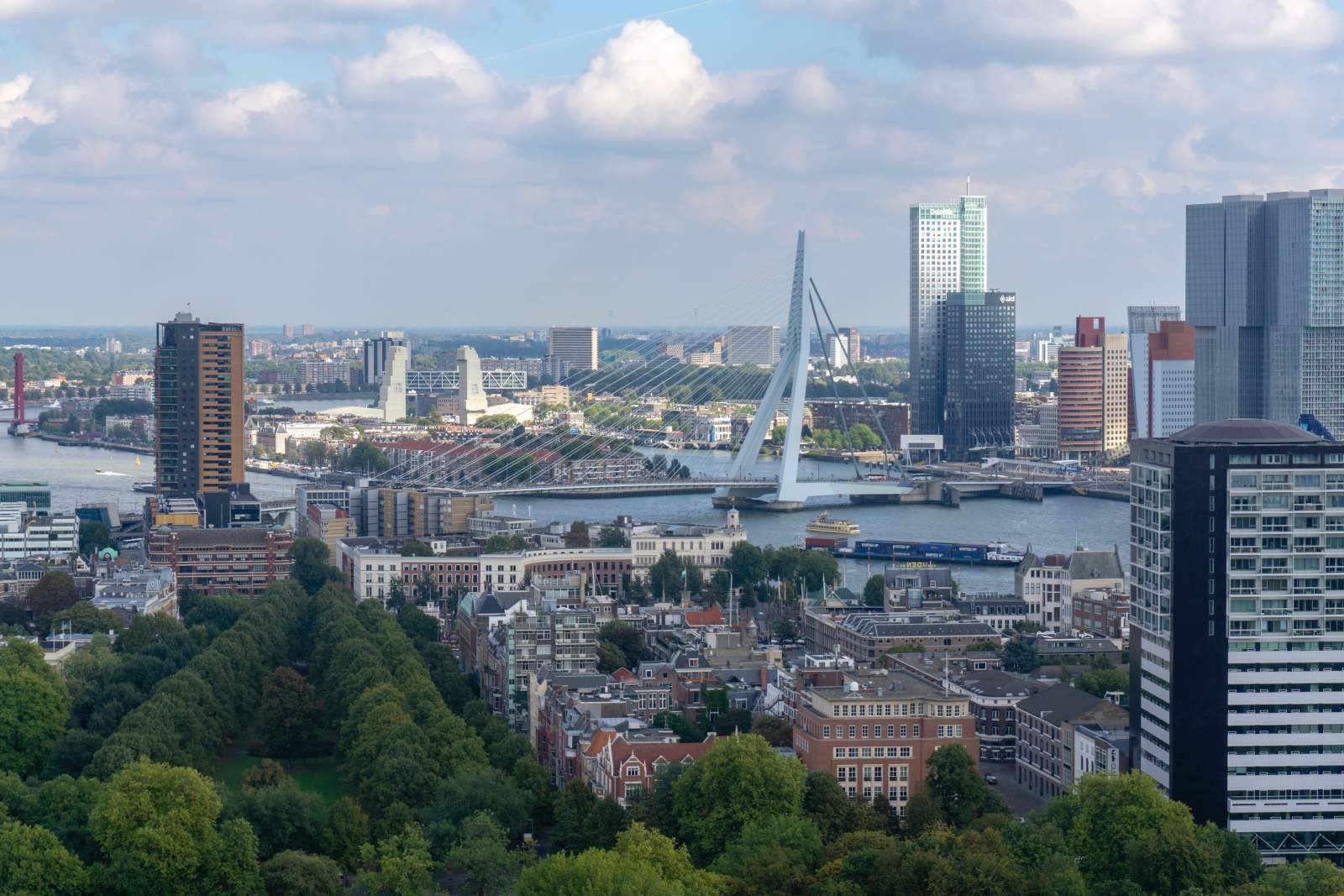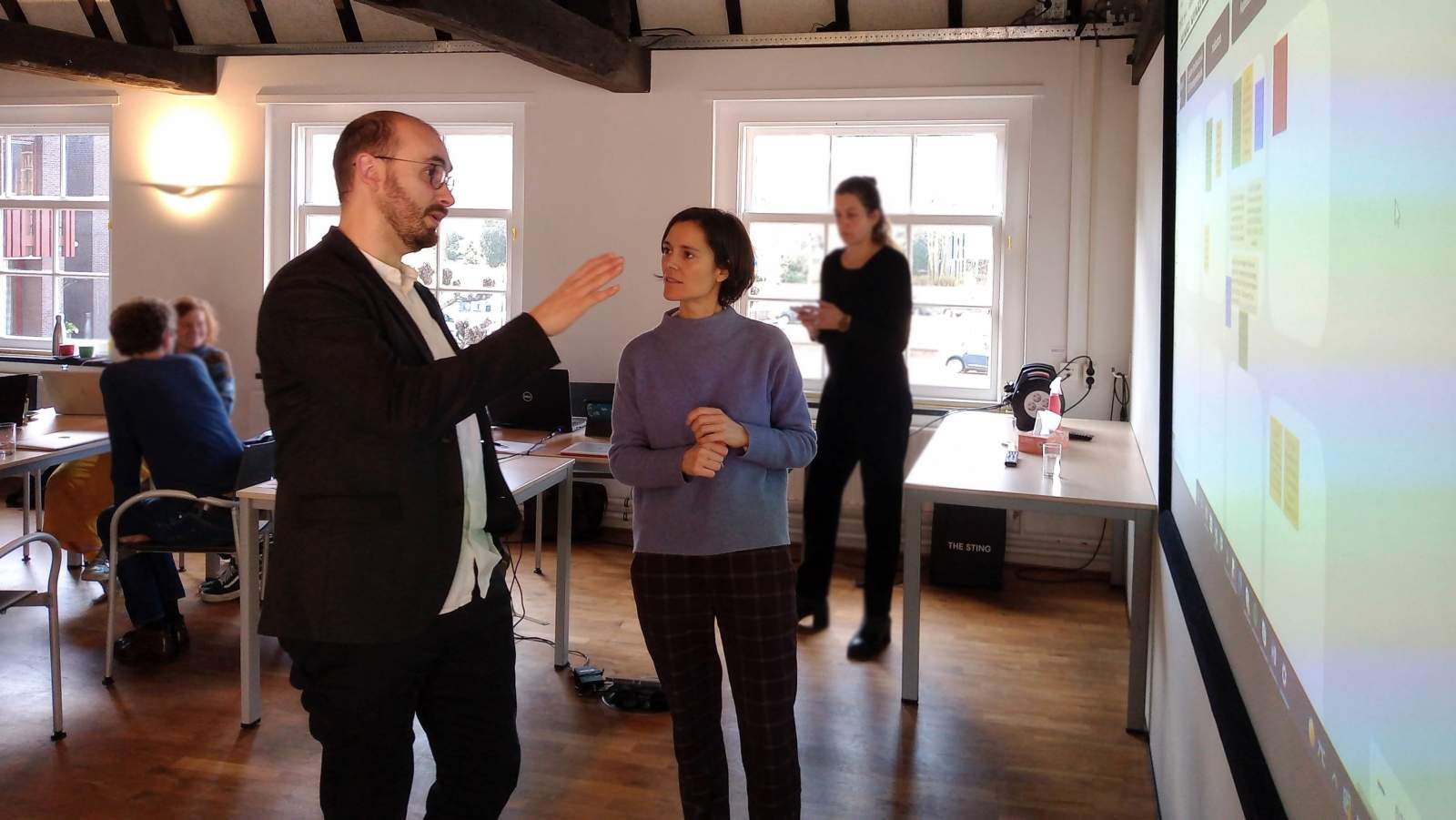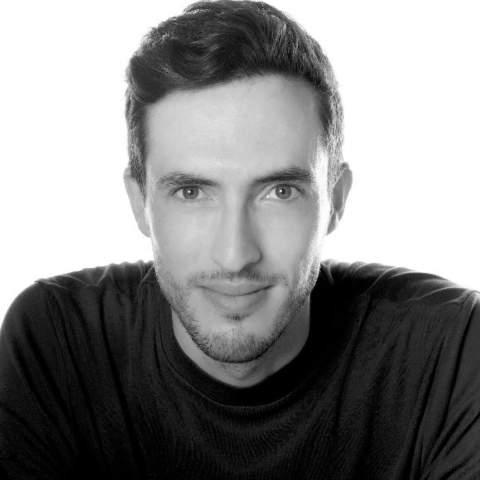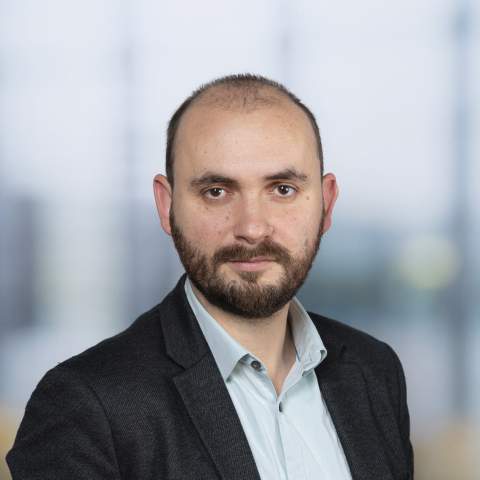João Cortesão (Wageningen University and Research*) and Claudiu Forgaci (Delft University of Technology) co-led the Urban Resilience working group during the DeSIRE research programme. Now they take the time to reflect on what brought them together and look forward to what the future may hold.
João, let’s start with you. You’re from Portugal, could you tell a bit more about your background?
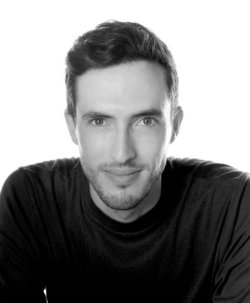 João: “I graduated on Architecture, followed by an internship on urban planning and urban design. Right after the internship, I decided to do a PhD because I wanted to dive into the field of bioclimatic design. In 2013 I received my PhD by the university of Porto and supported by Cardiff University. In the meantime, Portugal was undergoing an economic crisis, the unemployment rates were high and I could find no job. So, I decided to create my own job, as it were, and founded a start-up. This start-up was quite successful, we won awards and got commissions from both the public and the private sector. However, after two years I gravitated towards the academic world again and started a postdoc at Wageningen University and Research. The topic was what persuaded me to move to the Netherlands: the cooling effects of urban water bodies. After this project, in 2018, I became a tenure tracker in the DeSIRE programme and got my tenure with WUR in 2020.
João: “I graduated on Architecture, followed by an internship on urban planning and urban design. Right after the internship, I decided to do a PhD because I wanted to dive into the field of bioclimatic design. In 2013 I received my PhD by the university of Porto and supported by Cardiff University. In the meantime, Portugal was undergoing an economic crisis, the unemployment rates were high and I could find no job. So, I decided to create my own job, as it were, and founded a start-up. This start-up was quite successful, we won awards and got commissions from both the public and the private sector. However, after two years I gravitated towards the academic world again and started a postdoc at Wageningen University and Research. The topic was what persuaded me to move to the Netherlands: the cooling effects of urban water bodies. After this project, in 2018, I became a tenure tracker in the DeSIRE programme and got my tenure with WUR in 2020.
Claudiu, I believe there are similarities in your background, compared to João’s, isn’t it?
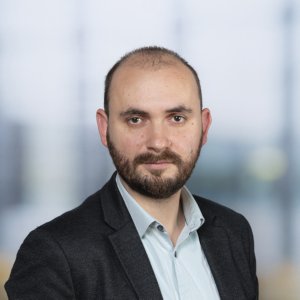 Claudiu: “There are! I studied Architecture in Romania. During my studies I already started working as an architect and continued to do so after graduation. I was employed at one of the best offices in Romania. It was very exciting to work with them and our projects were nominated for awards. However, I was missing something. I observed in my role that we as architects were oversimplifying the city. I wanted to improve my understanding of the complex dynamics of urban spaces and how they can be optimized to improve the quality of life for residents. During this process I got acquainted with the European post-master of Urbanism at the TU Delft, which was a renowned programme. This programme changed my perspective on architecture and urbanism, I learned about sustainability and sustainability issues in urbanism. I had a growing interest in resilience, especially in resilience of waterfronts, ecology in both urban and non-urban landscapes. After completing the post-master, I immediately started a Climate-KIC-funded PhD research, also at TU Delft, on the topic of integrated urban river corridors as strategic urban spaces of social-ecological resilience. Then, after a short postdoc, I joined the DeSIRE programme as a tenure tracker.”
Claudiu: “There are! I studied Architecture in Romania. During my studies I already started working as an architect and continued to do so after graduation. I was employed at one of the best offices in Romania. It was very exciting to work with them and our projects were nominated for awards. However, I was missing something. I observed in my role that we as architects were oversimplifying the city. I wanted to improve my understanding of the complex dynamics of urban spaces and how they can be optimized to improve the quality of life for residents. During this process I got acquainted with the European post-master of Urbanism at the TU Delft, which was a renowned programme. This programme changed my perspective on architecture and urbanism, I learned about sustainability and sustainability issues in urbanism. I had a growing interest in resilience, especially in resilience of waterfronts, ecology in both urban and non-urban landscapes. After completing the post-master, I immediately started a Climate-KIC-funded PhD research, also at TU Delft, on the topic of integrated urban river corridors as strategic urban spaces of social-ecological resilience. Then, after a short postdoc, I joined the DeSIRE programme as a tenure tracker.”
A common interest in the role of water in urbanism and urban resilience
What brought João and Claudiu together during the DeSIRE programme was their shared interest in water: João had just finished his postdoc on the cooling effects of urban water bodies and Claudiu had worked on integrated urban river corridors. Nowadays, their interests have slightly shifted, and especially João has a broader orientation on urban climate resilience.
What meant Resilience Engineering to you when you started, around 2018? “It wasn’t clear to me what the Engineering part was”, says Claudiu. “On a rather conceptual level, I knew what ecological resilience was. Later I learned about the social-technical component. Now it is clearer to me how the technical aspects of resilience can be engineered and how systems respond to disruptive events in an evolutionary way.” João: “The notion of Resilience Engineering developed over the years of being active in DeSIRE. I was a blank page at the start, regarding the word ‘resilience’. It was mostly due to conversations with colleagues and fellow DeSIRE tenure trackers that slowly my understanding of resilience developed and, of course, also by reading literature on the topic. What helped us really to grasp the notion of Resilience Engineering, in relation to the urban environment, was co-writing the mission statement for DeSIRE – we wrote this together with many fellow tenure trackers – and writing a book chapter together with Claudiu.”
Meandering to develop a research vision
João: “What I wanted to address at the start of DeSIRE was the role of water in regulating urban climates but also how to deal with rising of sea levels in the Netherlands.” However, after a while João gained a better understanding of how he could make a difference, that is, what his research niche could be. For João, the answer was looking back at his background in architecture and experience amongst urban designers and landscape architects. The eureka moment was: why not combining climate-responsive design, as in outdoor urban spaces, and bioclimatic architecture? Urban open spaces and buildings are two sides of one coin –there is just one urban landscape, which comprises buildings and open spaces, regardless of the function they fulfil. João visited Japan for a month, where he gained more understanding of his research niche. The core of João’s idea is to bring the two components, buildings and open spaces, together, to excel and improve resilience, climate responsiveness, energy use, etc. Put in disciplinary terms, this is about urban design, landscape architecture and architecture joining forces to achieve the needed systemic approach to creating resilient urban climates. In João’s research vision, the city is a living organism that can be effectively treated in a holistic perspective, especially when it comes to urban climate.
Claudiu’s journey in science wasn’t straightforward either. It was an iterative process to develop his current vision for research in the near future. Claudiu: “I started from a systemic understanding of resilience, mostly social-ecological resilience. How can I contribute to that? I am interested in finding out how systemic resilience properties can be translated into spatial properties and, vice-versa, how current spatial interventions affect urban resilience. Not all resilience properties are translatable to spatial properties and not all spatial interventions are carried out with knowledge and intent of resilience. That has been my challenge and niche since then.”
Claudiu develops design principles contributing to Resilience Engineering and busies himself with testing and refining them. Transdisciplinarity is something that has shaped Claudiu’s thinking. Claudiu: “To be able to operationalize resilience, you have to adopt a transdisciplinary approach and integrate multiple perspectives.”
Shaping a shared understanding of Resilience Engineering
João and Claudiu reminisce about the book chapter they wrote together, a tangible result of working together in the DeSIRE research programme at the 4TU.Centre for Resilience Engineering. Co-writing this chapter shaped how they thought about Resilience Engineering. Claudiu recounts, from heart, three aspects of resilience practices: plurality ("a city is multiple things at the same time”), transdisciplinarity (“the way those things work together”), and integration (“the operational aspect of bringing them together”). In the book chapter, these three aspects were attached to resilience actions and projects from Claudiu and João were fitted in, to illustrate how the framework could be applied.
João: “We held thought-provoking conversations. In the process we were taking our own stance both as individual researchers and as a group, the Urban Resilience working group.” João and Claudiu discussed how spatial design is fundamental to connecting the dots of the pluralistic nature of resilience. For example, connecting perspectives of different actors, stakeholders and disciplines. By becoming more aware of Resilience Engineering topics, both Claudiu and João also grew as teachers. João grew in what to expect from students, what type of feedback should you give, what type of challenges do you give.
DeSIRE was a nurturing community in which these discussions took place. Claudiu adds: “Working in this way and in this community is a big effort though. You have to get outside your comfort zone and it can be overwhelming. Finding the balance was just as important for me. I experienced that sometimes it would be too much and then I had to step back and reassess.” João agrees and adds: “Writing the mission statement for DeSIRE was, at moments, a formidable process, but we are very happy with the outcomes of this process and grateful for everyone’s efforts.”
Transdisciplinarity and a mixed methods approach go hand in hand
While talking about what resilience is, the topic that keeps popping us is how to actually measure resilience. Is there a way to quantify resilience and how do you assess resilience in a systematic way?
Claudiu says: “There are proven methods, such as agent based modelling and actor network analysis wherein resilience indicators are used quantitatively. However, resilience is a complex concept, it’s very dynamic and hard to quantify. Therefore another approach is to find a balance between quantifying resilience and qualifying perceptions of it. I am most interested in this combination, thus in my work, I apply a mixed-methods research approach to evaluating resilience.”
While working with and developing further mixed methods in urbanism, Claudiu also started to use more data and tried to incorporate a data science approach. Claudiu: “There is a bit of lag in catching up with quantitative approaches in urbanism and architecture. Knowledge of statistics, for instance, is becoming more and more important, yet still insufficiently available in the field.” João agrees with this.
João never used a single research method – he has always employed a combination of methods in his research projects, mostly based on Research Through Design. In research as well as in practice, spatial design naturally employs mixed methods. By staying true to the essence of design disciplines, this is the perspective that João intends to continue developing in future projects.
Thus, there is still a way to go. One leading question is ‘how can we cross feed and correlate different aspects of spatial design?’ For example, it would be interesting to measure health effects of cooling interventions. We know that trees provide coolness in urban areas, but how do we map out the beneficial properties? Asking the question about the cooling effects of trees is not a hard one to answer anymore; what now matters is to correlate the effects they provide with a variety of perspectives, from public health to the provision of other ecosystem services beyond climate regulation. To this end, it is key to have open and horizontal communication across different fields of knowledge and sectors.
Working with these insights, gained from collaborating and sharing experiences in the DeSIRE programme and the 4TU.Resilience Engineering community, is where both Claudiu and João continue to make their best efforts for the future.
Further reading
The book chapter: Cortesão, J., & Forgaci, C. (2023). Applied Urban Resilience Framework: Operationalizing Resilience in Urbanized Landscapes through Spatial Design. In K. Bishop & L. Corkery (Eds.), Routledge Handbook of Urban Landscape Research (pp. 195–207). Routledge. https://doi.org/10.4324/9781003109563
Recent articles
Cortesão, J., & Copeland, S. (2021). Urban Climate Resilience. In R. Brears (Ed.), The Palgrave Encyclopedia of Urban and Regional Futures. Palgrave Macmillan, Cham.
Lotfata, A., Cortesão, J., Zinsmeister, H., Steeneveld, G., van Zeben, J., Taylor, Z., Tan, W., & Elkhateeb, S. (2023). Climate adaptation in informal areas in hot arid climates. Sustainable Development. https://doi.org/10.1002/sd.2708
Suresh K., Forgaci C., Stead D. (2022). Developing an Integrated and Contextualized Planning and Design Framework for Livable Patterns of Urbanization in Chennai. Sustainability 14(16), 10178; https://doi.org/10.3390/su141610178
Naghibi, M., Faizi, M., Forgaci , C. & Ekhlassi, A. (2022). Transforming Leftover Spaces into a Resilient Urban Landscape in Tehran: A MICMAC analysis of Key Social-Ecological Factors. The Evolving Scholar | IFoU 14th Edition. https://doi.org/10.24404/6142217430e1a800088fb3dc
Forgaci, C. (2020). Smart and resilient cities: How can big data inform spatial design and planning for urban resilience? Contesti. Città, Territori, Progetti, 1, Article 1. https://doi.org/10.13128/contest-12035
Article written by Nienke D. Nijenhuis.




